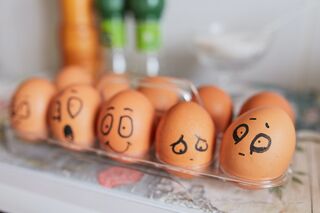Creativity
The Hardest Thing About Creativity
It's not coming up with the ideas.
Posted August 26, 2022 Reviewed by Ekua Hagan
Key points
- The creative process is full of emotional ups and downs.
- While creators love their work in general, daily work is full of anxiety, frustration, and self-doubt.
- Creators need skills in managing emotions to increase their creative persistence. These skills can be learned.

At the recent annual convention of the American Psychological Association, researchers examined how people make creativity happen. Although when we are impressed by a creative product or performance we tend to ask how they (creators) came up with ideas, it turns out that the most difficult part of doing something creative is not generating ideas, but rather dealing with the emotional side of creative work. The new research both teaches what to expect during the creative process and how to apply this knowledge in educational practice, making for important lessons at the start of a new school year.
Almost universally, creators describe the joy in their work and a sense of fulfillment from it. But while joy comes from the overall love of one’s work (scientists being passionate about what they study, designers desiring to build things, artists driven by a need to express and tell stories), daily work can be at times less than pleasant.
The great (greatest?) mystery writer, Agatha Christie, vividly described the emotional challenges of writing: “There is always, of course, that terrible three weeks, or a month, which you have to get through when you are trying to get started on a book. There is no agony like it. You sit in a room, biting pencils, looking at a typewriter, walking about, or casting yourself down on a sofa, feeling you want to cry your head off. […] And yet it seems that this particular phase of misery has got to be lived through.”
Vlad Glaveanu and colleagues interviewed creators working in different domains and confirmed that Agatha Christie was not alone in these feelings. They all talked about pleasure and satisfaction (“jubilation of being alive," “pleasure of making”), but that is far from the whole story. Artists talk about a range of unpleasant feelings, from melancholia to desperation, and describe the experience of their work as a series of crises plagued by constant self-doubt. Designers describe the external pressures from clients and the stress of conflicts with clients. Self-doubt is prominent. Scientists talk about many frustrations and describe boring and tedious parts of their work, especially when reporting their results (using the word “suffering” in relation to writing journal articles). Scriptwriters go through episodes of anxiety, depression, and anguish during writing, and music composers endure melancholy and “romantic sadness." Across the board, creators discuss creative blocks, which are experienced as frustrating and painful.
The challenge of creative work is to successfully make it through these emotional challenges to transform the initial, often vague ideas, into something tangible and delightful. The theory I developed with colleagues at the Yale Center for Emotional Intelligence describes how to be ready for the ups and downs of creative work. It is helpful to have realistic expectations of the nature of creativity (including awareness of its discomforts). People have to be able and adjust approaches as necessary and manage ambitious and usually ambiguous goals. To sustain the effort, persistence in the face of frustrating obstacles is crucial.
Our new research
The new research in my lab puts this theory to the test. We set out to measure the expectations people have before they engage in creative work and the strategies they use during the process of creation. We recruited a sample of professionally creative individuals (working in artistic professions, science, and technology, as well as other areas, like marketing and education) and a sample of people who were not selected for their creativity (general population).
Helpful expectations regarding emotions and creativity
We found that there are three kinds of expectations that are helpful in the creative process and they have much to do with emotions. First is the expectation of creativity as having ups and downs. This means assuming that there would be some frustrations and ongoing revisions to ideas and approaches to realizing them.
The second helpful belief is about the importance of completing one’s work. In other words, good enough, but not perfect is better than not completed at all, which can involve accepting a level of dissatisfaction with one’s work.
Finally, it is helpful to be aware that one’s work will be criticized and that there would be those who disagree or are otherwise displeased with it, as unpleasant (irritating, dispiriting) as that can be.
Strategies for successful creation
During the creative work, we identified three sets of potentially helpful strategies and one warning sign. Successful creation happens through curious exploration, tolerating uncomfortable ambiguities and uncertainties as the work moves along, and not getting emotionally stuck on a particular idea or way of building it.
Creators use some proactive strategies (e.g., planning on how to deal with interruptions before they happen to help stay focused) and self-motivation strategies (e.g., giving oneself a pep-talk when feeling stuck) to deal with potential triggers. Finally, to be truly creative—original and effective—creators purposefully pursue projects and ideas that include a measure of risk (i.e., choose projects that question assumptions in the field). They are not natural risk-takers who desire risk for its own sake, but they are willing to tolerate the risks to move their work in new directions.
Of course, sometimes not everything works right. Signs of the fragility in the creative process are primarily emotional—experiencing criticism as crushing and being discouraged by it to the point of giving up.
Our research showed that creative professionals had more realistic ideas about what to expect during creative work than people in the general population and that they were more likely to use strategies that can manage the emotional ups and downs of the creative process. Moreover, these expectations and strategies predict the level of creative achievement people attain (from dabbling in creative work and being complimented by friends and family to one’s work being nationally recognized for its creativity).
Teaching kids to manage emotions for problem-solving
Psychologists have a saying that there isn’t anything more practical than a good theory. Jessica Hoffmann and colleagues applied this research to educational practice. They described a program for middle and high school students called inspirED that guides real-life problem-solving. The program includes four stages in which student teams work to address an important problem in their schools.
First, students are guided in selecting problems to address needs at their school. To assist problem finding, students are given the tools to assess multiple aspects of school climate, such as safety and quality of relationships. Students are encouraged to ask questions about the meaning of the climate assessment (“What is surprising?” “What is the most concerning?”)
Throughout this, they learn that emotions, both positive and negative, can be helpful in identifying problems. Feelings of connectedness and pride point to what can be strengthened at the school and feelings of frustration show what can be changed and improved.
Most identified problems pertain to student-adult relationships, peer relationships, social and psychological safety, school pride, and support for diversity. And many of these problems are addressing feelings at school (“How can we monitor how students are feeling?” “What are ways to make school technology safer for all students?” “How can we help students become less stressed?”).
After identifying problems, students brainstorm ideas for potential actions. They are encouraged to come up with ideas that are within their power, competence, and interests. One insiprED team identified a problem of students feeling a lack of support from their peers and after considering different ideas, decided to create handmade valentines for every student in the school (more than 1,500 in total).
When working to realize their ideas, students experience a broad range of emotions, from being challenged, uncomfortable and anxious, to enjoying their work, feeling interested, and proud. Reminding themselves of the importance of the projects can become a strategy helping regulate fleeting emotions of self-doubt or frustration, which in turn helps them persist.
inspirED staff helps students accumulate small successes early in the process to build confidence. Celebrating smaller wins toward the larger project and thinking back to them become additional strategies for regulating emotions when feeling discouraged.
Learning about emotions during the creative process can help create realistic expectations of creative work. Knowing that anxiety and self-doubt are experienced by even the most successful creators can make us realize that such feelings are not a sign that we are not capable of creating. Rather, creativity is hard and the emotional aspects of it are the most difficult. The good news is that it is possible to learn how to manage and regulate emotions to help us transform creative ideas into performances and products.
References
Glaveanu, V., Lubart, T., Bonnardel, N., Botella, M., De Biaisi, P. M., Desainte-Catherine, M., ... & Zenasni, F. (2013). Creativity as action: Findings from five creative domains. Frontiers in psychology, 176. https://doi.org/10.3389/fpsyg.2013.00176
Ivcevic, Z., Hoffmann, J. D., McGarry, J. (2022). Scaffolding positive creativity in secondary school students. Educational Sciences. https://doi.org/10.3390/educsci12040239




